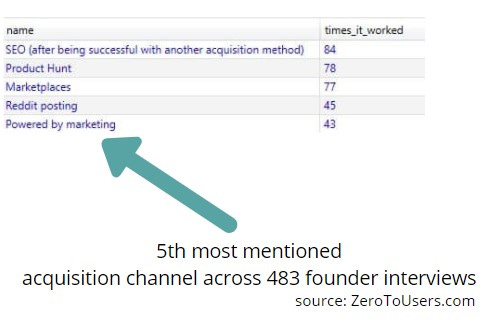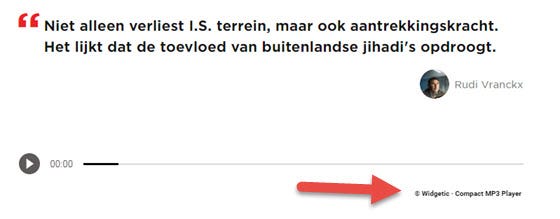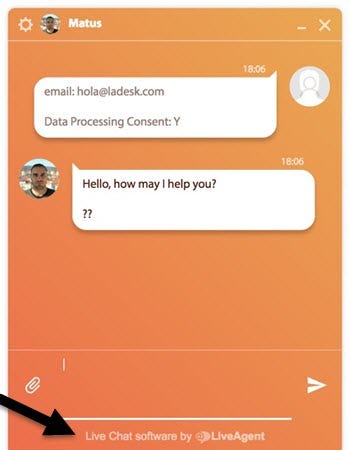"Powered by" - An Acquisition Channel Nobody is Talking About
My competitors are using this, I'll use it too.
I was reading through all 483 founder interviews on IndieHackers and was trying to discover what acquisition channels do consistently work for founders (as part of my upcoming research report).
After getting to the 100th interview, I’ve noticed a particular acquisition channel that was being mentioned as often as SEO, press outreach and affiliate marketing. The thing is, everyone knows about affiliate marketing and SEO. There are even experts/agencies that solely focus on mastering these channels.
Yet, (almost) no one talked about this one...despite it being consistently (over 43 times) mentioned by founders as a viable growth channel that worked for them. Maybe the reason for this is that this method is so simple to implement...yet so effective.

What is this mysterious growth channel? After giving it some thought, I’ve decided to name it “powered by” marketing, and the best way to explain it is with an example (read on).
My Competitor is “Powered by” this tool. I’ll Use it Too.
Widgetic ($3.3k/m) is an embeddable widget provider which gives newspaper articles more interactivity by enabling them to add things like quizzes, live voting and so on. Here’s what they noticed after they got a few customers:
What we noticed is that as soon as we enter a market, other newspapers start using our app. This is because journalists read their competitors! :-) So usually we had to reach out to 2-3 major newsrooms in a country, and once we get published the majority of the other publications find out about us and sign-up by themselves. (source)
How did competitors find out their local competitor used Widgetic?

Notice that small “powered by” link at the top right corner? Well, it’s clickable (you can find a live demo here).
Widgetic is not the only company that discovered the power of “powered by”. LiveAgent ($250k/m), a help desk & live chat software, has also mentioned it’s been one of their primary growth channels:
One of the friends was a local web hosting company. After they started using LiveAgent, we noticed that three out of four other leading local web hosting companies started using it as well, and they all continue to use it now.
Word of mouth and branding displayed on our widgets such as "Live Chat Software by LiveAgent" were bringing in 50% of new leads… (source)
Here’s how LiveAgent “powered by” link looks:

Here’s a simple fact: Competitors copy each other. If business A is using a certain tool, and B is their competitor, B will notice that and take a look. If competitor B determines that the tool gives A a certain competitive “edge”, they’ll most likely start using it for themselves as well.
“Powered by” Does Not Have to be a Link
Even if you don’t have a “powered by” link, some businesses take an extra step to find out what their competitor is really using. Take Epic Plugins and Themes ($5k/m) who provide premium Wordpress plugins/themes, and their story of how they launched their second theme:
The Reddit for WordPress theme was actually used as the theme for growthhackers.com back in 2013, but it was heavily customised on the front end with Bootstrap. They kept the same underlying functionality and scripts that I had written.
This got picked up by someone who had found out which theme Growth Hackers was using and asked me how they could customise the theme to "be like Growth Hackers."
This wasn't a straightforward modification, so I agreed to build it for them at a discounted freelance rate and keep the resell rights. This then became my second theme. (source)
My guess is that this person found about Epic Themes by inspecting the source of GrowthHackers.com. They probably left an HTML comment there, mentioning the name of their company, or some clear trace which showed who they are.
Use the power of default
If you’re thinking of whether to use a “powered by” link for your own product, but don’t want to force it down the throat of everyone, you can make it optional...and use the power of default.
EndCrawl ($20k/m) did this. They are a SaaS tool that generates end credits (those boring lists of names of every actor/director at the end of movies). When asked how they attracted users and grown revenue, here’s one of the things they mentioned:
Worked: Native Ads
We place our name and logo in all new Endcrawl projects. Customers can remove them if they like of course, but the power of default is strong. As a result, our name and logo are sprinkled across hundreds of films and will be seen for many years to come.
We encourage all founders to think creatively about what constitutes a "native ad" in their space. (source)
The power of default has been demonstrated in many fields. EndCrawl calls this approach “native ads”, which makes sense if you define “native” as “letting other people know (including competitors) who made this feature”.
“Powered by” Starting From the Top of the Chain
Small guys in an industry want to copy the big guys (often mindlessly). Take, for example, the endless posts on HackerNews about microservices, big data and, similar things, primarily used by big companies like Google, and often (mis)used by smaller startups. Or take the leading video hosting company, YouTube. Every now and then they release a new feature, and smaller competitors are quick to copy it to their sites, without taking into considering whether that feature really makes sense for their site.
“Powered by” marketing is no exception. If smaller guys see that you “power by” the big guys in their markets, they are far more likely to follow suit.
Discourse ($120k/m), now a popular discussion software, gained a lot of their visibility by first limiting themselves to big discussion boards. When asked how did they attract users and grew revenue, Jeff Atwood said:
We also focused on getting three big beta customers who, in return for running our rather raw beta software on their real live sites, we promised white glove anything goes support and free hosting for two years, and then at considerably reduced rates thereafter.(Source)
I myself remember visiting a lot of popular discussion boards like SitePoint, and noticing a whole different experience. It didn’t take much to realize what platform they started using/switched to (many of the sites had blog posts announcing the “powered by” change, and for some other boards it was more obvious because they have the name “discourse” in the sub-domain itself). As those guys started adopting Discourse, smaller guys also took notice.
Being the “powered by” engine of a big guy doesn’t just attract smaller guys, but other big guys as well. Planio ($110k/m), a project collaboration SaaS, said:
A second big win early on was when Software AG, one of the largest software companies in Europe, became a customer. That gave us a cushion in terms of revenue, and it gave us credibility with other larger companies. Now, we're quite proud to be serving big brands such as Allianz, Seagate, Staples, Citrix, etc. (source)
Sciter Engine, an embeddable UI engine for desktop apps also noticed this:
My first major client was Symantec, who gave the product a major boost in 2006 when they started using it for the UI of all their customer-facing products, including Norton Antivirus, Norton Internet Security, and others. After this endorsement, all major anti-virus vendors joined "Sciter UI club." (source)
Using “Powered by” Marketing For Your Product
Now, you’re probably saying: This “powered by” strategy isn’t suitable for every niche. For example, Planio is a project management software, and companies don’t just display what project management software they use! And you’re right. In some industries, saying you “power by” some company is more difficult. But there is ALWAYS a way.
For example, Planio blogged a case study about Software AG (and guess what: competitors Google the names of other competitors. Some even actively monitor it.) I’ve actually in touch with Planio founder and he told me that all of their leads are inbound. This sort of confirms my hypothesis, that competitors definitely track their competitors.
Here are some things I’ve seen founders do to use the power of “powered by” to market their product:
- Sending a cold email to competitors, giving some proof that you “power by” some of the major players in their market
- Negotiate so the company you “power by” covers you on their own blog/twitter/other public profile. Maybe do a case study or a collaborative post.
- Do something so the company your product powers by is feeling proud. Announce they’re a “golden customer”, give them some trophy, bonus, which will contribute to them mentioning you on their Twitter/Facebook/blog.
“Powered by” marketing is like social proof, where the “proof” part is on steroids. Usually, when people say “social proof, they mean saying who’s your customer etc. This is taking this on a whole new level, PROVING that they use you, in a way that can be verified (like you being listed on the company’s site, the company’s site mentioning you on their FB/Twitter feed and so on.)
Next: Engineering as Marketing
My next post will be about ‘engineering as marketing’. I’ve seen people mention it, but the examples they give are pretty limited/everyone knows about them. Feel free to subscribe to my ZeroToUsers newsletter to get notified on when I release this post.

Awesome post. Did you ever release "engineering as marketing" as I never understood that term?
gems...